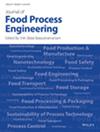GHG comparison of frozen milk concentrate and milk powder
Abstract
Increased awareness by industry of greenhouse gas (GHG) emissions is forcing companies to examine electrical technologies as alternatives to fossil fuel-driven thermal ones. Spray drying of milk is recognized as a high-energy process and is of particular importance to New Zealand. It requires inlet air temperatures higher than most existing electrically-driven heat-pumps can reliably achieve. Already some companies internationally are considering freezing and shipping milk concentrates rather than drying which begs the question as to whether the GHG emissions of frozen concentrate outweigh the GHG avoided by not drying. This research note assesses the relative GHG emissions and indicates a GHG advantage for frozen concentrate shipping.
Practical applications
Increased awareness of the significance of greenhouse gas (GHG) emissions is forcing companies to examine alternatives to fossil fuel-driven thermal technologies. Spray drying of milk is recognized as a high-energy process and is of particular importance to New Zealand. It requires inlet air temperatures higher than most existing electrically-driven heat-pumps can achieve and so commonly requires fossil-fuel use. Already some companies internationally are considering freezing and shipping milk concentrates rather than shipping dried milk. This research note assesses the relative GHG emissions of conventional (fossil-fuelled) processes, and a novel process involving frozen concentrate. The evaluation shows that significant greenhouse gas reduction is possible by shipping frozen concentrate.

 求助内容:
求助内容: 应助结果提醒方式:
应助结果提醒方式:


